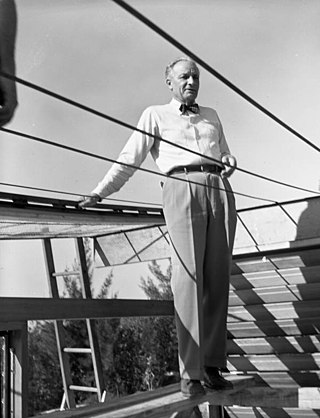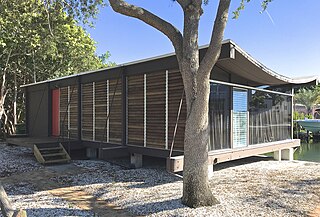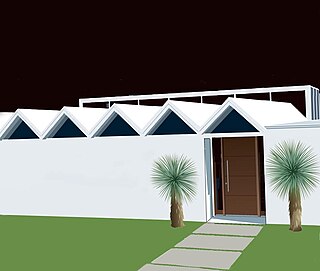
Paul Marvin Rudolph was an American architect and the chair of Yale University's Department of Architecture for six years, known for his use of reinforced concrete and highly complex floor plans. His most famous work is the Yale Art and Architecture Building, a spatially-complex Brutalist concrete structure. He is one of the modernist architects considered an early practitioner of the Sarasota School of Architecture.
Gene Leedy was an American architect based in Winter Haven, Florida. He was a pioneer of the modern movement in Florida and later a founder of the Sarasota School of Architecture, whose members included Paul Rudolph, Victor Lundy, and others. After beginning his career in Sarasota, Leedy moved his practice to Winter Haven in 1954. He is best known for his bold use of precast concrete, especially in long-span, "double-tee" structural elements.

Riverview High School is a four-year public high school in Sarasota, Florida, United States. Riverview educates students from ninth grade to twelfth grade. The school has 2,654 students and 129 teachers. The school's mascot is the ram. As of the 2012–2013 school year, it is the largest school in the county.

The Sanderling Beach Club is a historic Sarasota School of Architecture building in Sarasota, Florida, United States. It was designed in 1952 by architect Paul Rudolph.

The Sarasota School of Architecture, sometimes called Sarasota Modern, is a regional style of post-war modern architecture (1941–1966) that emerged on Florida's Central West Coast, in and around the city of Sarasota, Florida. It is characterized by open-plan structures, often with large planes of glass to facilitate natural illumination and ventilation, that address the unique indigenous requirements of the regional climate. Many of the architects who pioneered this style became world-renowned later in their careers, and several significant buildings remain in Sarasota today.

Mary Rockwell Hook was an American architect and a pioneer for women in architecture. She worked principally from Kansas City, Missouri but designed throughout the United States. She was denied admission to the American Institute of Architects (AIA) due to her gender.

John Howey was a Florida architect known as part of the group of architects at work since 1965 that followed the Sarasota School of Architects led by Paul Rudolph. John Howey Associates is his Tampa Bay architectural firm formed in 1973. Some of his projects include Tampa City Hall Plaza, Village Presbyterian Church, and the Williers Residence in Tampa. John Howey passed away on Saturday, October 26, 2019.
Jack West (1922–2010) was an architect in Sarasota, Florida and briefly in Southern California. West was one of the leaders of the Sarasota School of Architecture.

Ralph Spencer Twitchell was one of the founding members of the Sarasota School of Architecture. He is considered the father of the group of modernist architecture practitioners, that includes Paul Rudolph and Jack West, and other modernist architects who were active in the Sarasota area in the 1950s and 1960s like Ralph and William Zimmerman, Gene Leedy, Mark Hampton, Edward “Tim” Seibert, Victor Lundy, William Rupp, Bert Brosmith, Frank Folsom Smith, James Holiday, Joseph Farrell and Carl Abbott. He bridged the more traditional architecture of his early work in Florida during the 1920s with his modernist designs that began in the 1940s.

William J. Rupp was one of the modernist American architects considered part the Sarasota School of Architecture.
Guy Wesley Peterson is an American architect based in Sarasota, Florida. Peterson is a Fellow of the American Institute of Architects and the recipient of the AIA Florida Gold Medal for his outstanding contributions to architecture. He has designed more than 200 structures in southwest Florida, including notable private and public works. Peterson is an adjunct professor of architecture at the University of Florida, College of Design, Construction and Planning, and the author of Naked: The Architecture of Guy Peterson.
Edward John "Tim" Seibert was an architect based in Sarasota, Florida. Seibert was a Fellow of the American Institute of Architects and one of the founders of the modern movement known as the Sarasota School of Architecture.

The Healy Guest House is a small guest cottage located in Siesta Key, Florida, originally built for Mr. and Mrs. W. R. Healy. It was designed in 1948 by Paul Rudolph and Ralph Twitchell during their five-year partnership that sparked a modern architecture movement in Florida; the Sarasota School of Architecture. Its radical shape, featuring an inverted catenary roof, was an experiment in structure and technology. It is considered one of the most significant architectural works of the twentieth-century.

Lamolithic house was the term given by Sarasota concrete businessman John Lambie to describe his unique method of building modern reinforced concrete residential structures. This building technique enabled the fabrication of thin ceiling and wall planes, thus enabling architects to draft efficient and lightweight designs. Several historic lamolithic houses were constructed by renowned architects Paul Rudolph and Ralph Twitchell on Siesta Key, Florida using this technique. These homes were among the earliest examples of reinforced concrete residential construction.

The Hiss Residence is a mid-century modern home designed by architect, Paul Rudolph. Built as the show home for Sarasota's Lido Shores neighborhood in 1953, the structure blends international style modernism with indigenous tropical design. It is among the preeminent works of the Sarasota School of Architecture and considered “one of the most remarkable homes of the twentieth century.”

The Walker Guest House was a compact modern beach structure originally built on Sanibel Island, Florida, for Dr. Walter Walker. It was designed in 1952 by Paul Rudolph as an architectural response to Mies van der Rohe’s Farnsworth House and Philip Johnson’s Glass House. It is considered a ground-breaking work of environmental design, and one of the most important works of architecture of the twentieth century.

Tollyn J. Twitchell was a 20th-century architect who designed buildings for Twitchell Architects. He designed the Carousel House, the ZigZag House, the Sailor Circus arena, Unitarian Universalist Church of Sarasota, Gulf Gate Elementary School, and the Jefferson Center.

The Zigzag House (1959) is a residential house in Sarasota, Florida, United States. It was designed by architect Tollyn Twitchell in the style of the Sarasota School of Architecture: the style is also referred to as a mid-century modern. The home has been named for its zigzag roofline which resembles saw teeth.

Milam Residence is an oceanfront residence in Ponte Vedra Beach, Florida, United States. It was designed by architect Paul Rudolph in the style of Sarasota Modern. The late modernist home has an unusual facade of large geometrical shapes facing the ocean. Completed in 1961, it was one of Architectural Record's 20 "Record Houses" of 1963. In 2016, it was added to the National Register of Historic Places.

Bass Residence (1970) is a home in Fort Worth, Texas classified as Modern architecture and designed by architect Paul Rudolph, a founder of the Sarasota School of Architecture, and he designed the home in that style. It was designed for Sid Bass and Anne Bass. The house features cantilevered horizontal shapes.






















